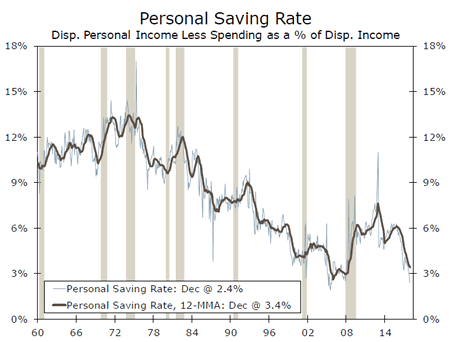U.S. Review
The Economic Calendar Was Quiet this Week
- It was a light week in terms of new economic data, but the main indicators we got all came in above expectations and point to a strong underlying domestic economy.
- The ISM non-manufacturing index hit a cycle high in January, signaling a strong start to 2018 for businesses. The headline was helped by a bump in new orders, suggesting current business optimism has legs for the next few months.
- The United States’ trade deficit widened further in December, as import growth outweighed growth in exports. Domestic and global demand have strengthened.
Economic Data Stay the Course
The few readings on the economy this week continued the string of positive news about underlying economic fundamentals. The ISM non-manufacturing index posted a solid rebound in January after service sector activity took a breather in November and December. The headline rose to hit a new cycle high of 59.9. The improvement in new orders was the main driver of the recovery, but the breadth of positive responses across industries was also notable. The new orders index rose 8.2 points to a reading of 62.7 in January, which is the strongest since 2011. Business activity was up, measured by the business activity index and the tone of the comments in the press release. Many noted optimism stemming from the tax changes, and also that prices were picking up. Indeed, the nonmanufacturing prices paid index rose on the month, following the manufacturing survey in pointing to a stronger price pressure environment. January is often when businesses test pricing power, so we will follow this closely in months ahead to see if it holds.
The ISM non-manufacturing employment component hit a fresh series high of 61.6 in January, which is a very promising sign for hiring. The Department of Labor also released the Job Openings and Labor Turnover Survey (JOLTS) for December. The number of available jobs open at the end of the year declined on the month, drifting further from its likely high-water mark posted in October. The hiring rate has yet to reflect much of a shift in trend. Turnover as measured by total separations rose despite a drop off in the number of layoffs. The number of workers that left their jobs voluntarily during the month was at its cycle high. That suggests a rising sense of optimism about job prospects elsewhere, which should also come with pay increases. The number of quitters jumped solidly but resulted in only a slight increase in the quit rate, or quits share of total employment, which remained bound in the 2.1-2.2 percent range for the 12th month in December. We expect this rate will break out to the upside in 2018 as the available labor supply shrinks further, prompting hiring managers to offer higher wages that entice those already employed to leave for more lucrative pastures. This underpins our call that inflation will firm this year, prompting the Fed to raise interest rates three times.
The global economy is currently experiencing synchronous growth, as most nations are seeing rising demand. The upswing in demand overseas along with the weakening of the U.S. dollar has been a boon for U.S. exports, which rose 1.8 percent in December to their highest point on record. American demand propelled a 2.5 percent monthly rise in imports, which resulted in a larger than expected widening of the U.S. trade deficit. The larger widening of the deficit in Q4 may result in trade taking a larger chunk off Q4 GDP than the 1.13 percentage points estimated in the advance GDP report. Still, the larger volume of trade between the U.S. and the rest of the world is a positive for both domestic and foreign economies, even if it results in a slight drag from trade in the GDP calculations. The consumer credit report was also released this week. It showed a slight cool down in December following November’s cycle-record increase, when Americans racked up credit card balances for the holidays.
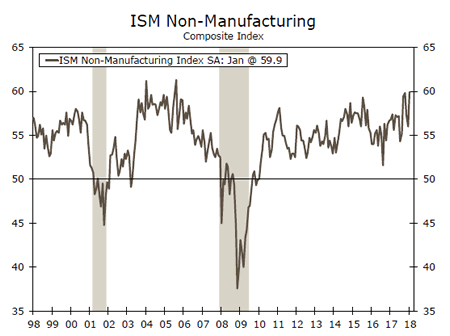
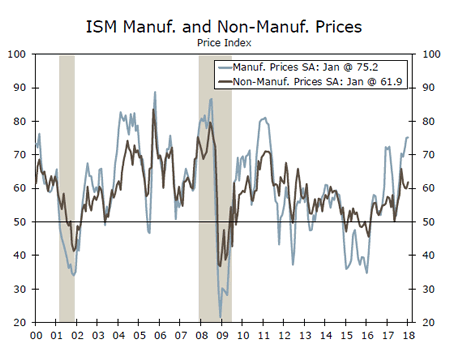
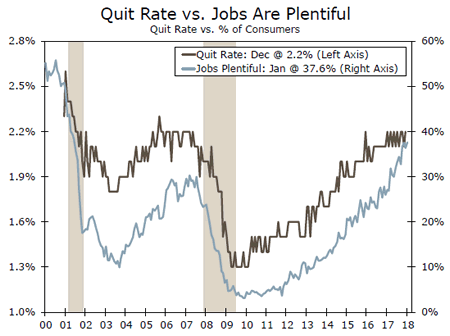
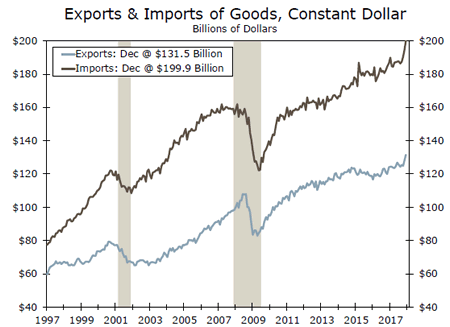
U.S. Outlook
CPI • Wednesday
The Consumer Price Index (CPI) increased 0.2 percent in December, following November’s stronger 0.4 percent gain. Contributing to relatively slower growth on the month was a 0.8 percent decline in gasoline prices. Core inflation, which excludes the volatile food and energy prices, increased in December by 0.2 percent. Core goods prices increased 0.2 percent, helped by increases in vehicle and prescription drug prices. Services also helped core inflation, with shelter costs growing by a larger-than-usual 0.3 percent.
Low levels of inflation have been the primary concern in the Fed’s move to raise interest rates. However, inflation has shown a stronger trend recently, at a 2.5 percent three-month annualized pace, with core inflation at 2.3 percent. We expect consumer prices to jump to a stronger pace as we move into the spring. Should inflation pick up as we expect it to, the Fed’s concern of low inflation should dissipate and continued rate hikes should follow.
Previous: 0.2% Wells Fargo: 0.3% Consensus: 0.3% (Month-over-Month)
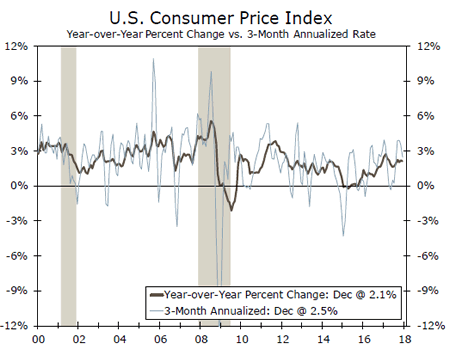
PPI • Thursday
The Producer Price Index (PPI) declined 0.1 percent in December to close 2017. This marks the first contraction in producer prices since August 2016 and follows five consecutive monthly gains. The drop was driven by the first decline in services prices in 10 months. Food prices fell 0.7 percent, trade services declined 0.6 percent and energy prices were unchanged on the month. Excluding these three components, the PPI recorded a slight 0.1 percent gain in December and is up 2.3 percent over the year.
Despite December’s headline decline, the PPI exhibited strong growth in 2017. Commodity prices have trended higher overall, and the economy is showing signs of promise behind more job gains and historically high levels of confidence among both consumers and businesses. For these reasons, we believe producer prices should continue their upward momentum into this year.
Previous: -0.1% Wells Fargo: 0.4% Consensus: 0.4% (Month-over-Month)

Housing Starts • Friday
Housing starts fell drastically in December by 8.2 percent. However, this appears to be due to winter volatility, as November’s starts were exaggerated to the upside due to unseasonably warm weather. The December slowdown was fully driven by single-family starts that fell 11.8 percent, while multifamily starts rose 1.4 percent. For the whole of 2017, starts rose 2.4 percent thanks to an 8.4 percent increase in single-family starts.
Housing permits were stronger than starts to close the year, indicating a likely ramp-up in homebuilding to start 2018. We expect tax reform and rising construction input costs to lead to a shift away from higher-priced homes in 2018. We call for single-family starts to rise 10.8 percent in 2018, and we have also boosted our multifamily forecast as tax reform should bolster apartment demand further.
Previous: 1,192K Wells Fargo: 1,234K Consensus: 1,228K (SAAR)

Global Review
Balancing Growth & Inflation: Central Bank Challenges
- The Bank of England kept its main policy rate steady at its meeting this week, but still above-target inflation and diminishing slack led policymakers to adopt a hawkish tilt.
- The Reserve Bank of India also kept monetary policy unchanged, though stronger inflation has accompanied the turnaround in economic growth that took place at the end of last year.
- Canadian employment growth came crashing back down to Earth in January after two strong previous months. Encouragingly, full-time employment rose by 49,000, although part-time employment fell by 137,000.
Balancing Growth & Inflation: Central Bank Challenges
Across the pond, the Bank of England held its main policy rate steady at its meeting this week, but upward revisions to the central bank’s growth forecast and hawkish commentary caused sovereign bond yields to jump. The policy statement noted that the U.K. economy "has only a very limited degree of slack" amid an increasingly broad-based recovery. Robust foreign demand and a weak currency have aided economic growth; data on manufacturing output released this morning showed production rising for the eighth consecutive month, the longest streak in three decades. Additional data released today showed U.K. exports climbing a strong 11 percent in 2017.
Inflation continues to run above the 2 percent target, mostly due to sterling’s depreciation post-Brexit (top chart). This combination of diminishing slack and above-target inflation has "diminished the trade-off that the MPC is required to make," an implicit nod to tighter monetary policy on the horizon. For more on the MPC and our international rate outlook, see this week’s Interest Rate Watch on page 6.
The Reserve Bank of India (RBI) also held its main policy rate steady at 6.0 percent this week. A slowdown in both economic growth and inflation brought on roughly 200 bps in policy rate easing over the past few years. More recently, however, inflation has strengthened across a broad range of categories, and economic growth in Q3-2017 reversed a slowdown that had stretched for five consecutive quarters (middle chart).
The fading effects from demonetization and a solid global growth backdrop should bode well for the Indian economy, though the RBI notes that rising commodity prices could act as a drag on aggregate demand if sustained. The policy statement finished by noting that "the Committee is of the view that the nascent recovery needs to be carefully nurtured and growth put on a sustainably higher path" suggesting the RBI is in a wait-and-see mode in regards to monetary policy.
Elsewhere, Canadian employment came crashing back down to Earth, falling by 88,000 jobs in January. As we noted in last week’s international outlook, November-December saw the second-strongest two-month period of job growth, so some payback this month was likely inevitable. That said, the decline far outstripped even the most pessimistic of forecasters, with the monthly contraction in payrolls resembling the declines seen during the throes of the Great Recession (bottom chart).
Part-time employment declined 137,000 in January, the largest decline in part-time employment on record. The run-up and subsequent collapse in part-time employment growth over the past few months suggests some seasonal/timing quirks around the turn of the year. Encouragingly, full-time employment actually rose 49,000 in January, higher than December (23,200) or November (35,500). Smoothing through the monthly volatility, total monthly employment growth has averaged about 19,000 over the past three months, more or less in-line with the 21,000 averaged over the previous three-month period from August-October.

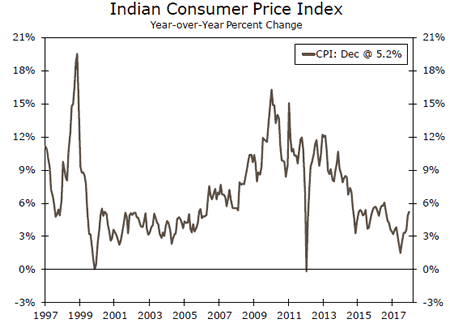
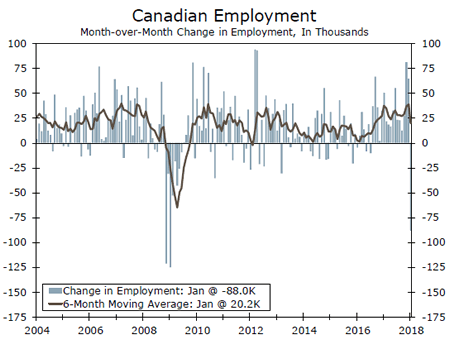
Global Outlook
Japanese GDP • Wednesday
Real GDP in Japan has risen on a sequential basis for seven consecutive quarters, the longest unbroken string in 16 years. Although it appears that real GDP growth slowed in the fourth quarter, we estimate that the economy continued to expand for an eighth consecutive quarter. Although real GDP was up only 2.1 percent on a year-ago basis in Q3-2017, the expansion has generally been broad based across spending categories, which makes it more sustainable. Indeed, we look for the expansion to continue through 2018 and 2019.
Private non-residential fixed investment spending was up 4.0 percent on a year-ago basis in Q3. On Thursday, December data on core machinery orders, which are a good leading indicator of fixed investment spending, will be released. The outturn will give analysts some insights into the current state of capital spending.
Previous: 2.5% Wells Fargo: 2.1% Consensus: 1.0% (SAAR)
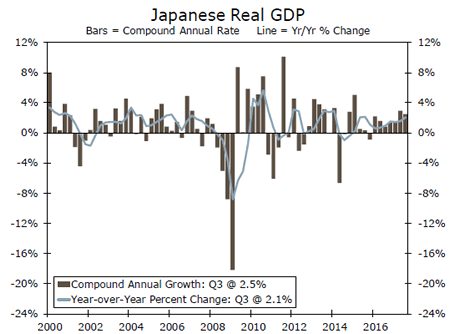
Eurozone Industrial Production • Wed
Industrial production (IP) in the Eurozone accelerated in 2017. Indeed, IP in the October-November period was up 3.5 percent on a year-ago basis. Data slated for release on Wednesday will show how IP in the euro area ended the year. Although we already have preliminary GDP data for the fourth quarter—real GDP grew 2.7 percent (year-over-year) in Q4-2017—the IP data will give analysts some insights into the momentum the industrial sector had coming into 2018.
Speaking of GDP growth, the first disaggregation of Eurozone GDP into its demand-side components will be available on Wednesday, and many individual economies in the Euro area will release their own GDP data as well. France will print its labor market report for the fourth quarter on Thursday.
Previous: 1.0% Consensus: 0.0% (Month-over-Month)

U.K. Retail Sales • Friday
Consumer spending in the United Kingdom decelerated markedly last year. The sharp depreciation of the British pound in the aftermath of the Brexit referendum in June 2016 lifted inflation and eroded consumer purchasing power. As growth in real income slowed, so too did growth in consumer spending. Data on retail spending in January that are on the docket on Friday will offer some insights into the state of consumer spending early in 2018.
The value of sterling has stabilized over the past year, and the impulse to inflation from exchange rate depreciation is fading. Consequently, we expect CPI inflation to recede in coming months from its current rate of 3.0 percent. CPI data for January that are slated for release on Tuesday will show if this process has started yet. Producer price data for January, which will also print on Tuesday, will offer further insights into the current inflation dynamics in the British economy.
Previous: -1.5% Consensus: 0.6% (Month-over-Month)
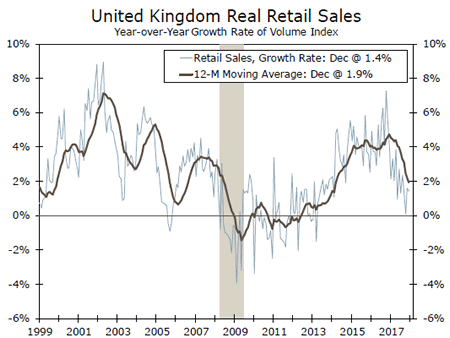
Point of View
Interest Rate Watch
Bank of England Turns Hawkish
The Monetary Policy Committee (MPC) at the Bank of England held a policy meeting on February 8 and, as widely expected, the MPC voted unanimously to keep policy unchanged. Specifically, the MPC voted 9-0 to keep the Bank’s main policy rate (i.e., Bank Rate) unchanged at 0.50 percent, where it has been maintained since November (top chart).
However, the MPC sounded hawkish in the statement that it released after the meeting. The MPC said that "the U.K. economy has only a very limited degree of slack" and that "domestic inflationary pressures are expected to rise." Therefore, the MPC projects that monetary policy will need to be tightened "somewhat earlier" and "by a somewhat greater extent" than it deemed appropriate three months ago.
Accordingly, we have made some changes to our U.K. interest rate outlook. We had thought that the MPC would wait until Q4 of this year before hiking rates again, but we have moved up the next rate hike to Q3. In addition, we now see the Bank Rate at 1.50 percent at the end of 2019 rather than at 1.25 percent. The 10-year government bond yield in the United Kingdom has followed comparable yields in the United States and Germany higher over concerns of higher inflation (middle chart), and we have made some adjustments to our forecast for gilt yields.
We have not made any changes to our outlook for ECB policy, at least not at this time. The Governing Council has said that it intends to buy €30 billion worth of bonds per month, and we take ECB policymakers at their word (bottom chart). But we believe the Governing Council will decide to wrap up its quantitative easing program rather quickly, and look for it to cease buying bonds by year-end 2018. We also think the ECB will not waste much time in hiking rates. We look for the Governing Council to raise its deposit rate from 0.40 percent to, say, -0.20 percent in the first half of 2019 and then to hike all three of its policy rates not too long thereafter. Expectations of rising rates in foreign economies should lead to further U.S. dollar depreciation going forward.
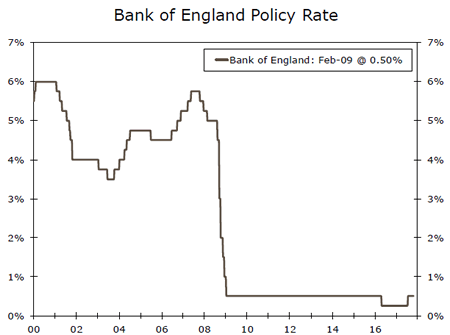

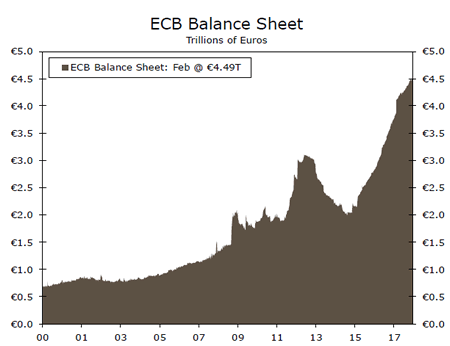
Credit Market Insights
Consumer Lending Remains Solid
The January Senior Loan Officer Opinion Survey (SLOOS) on bank lending practices affirmed generally solid consumer lending standards seen through the end of 2017. Banks reported that consumer lending standards were basically unchanged in Q4, while a modest number of banks reported tighter standards for credit card loans.
The January lending survey data come amid soaring levels of consumer credit. November’s print was upwardly revised to a cycle-high $31.0 billion, followed by a stillhealthy $18.4 billion increase in December. Generally easy lending standards likely contributed to the up-tick in consumer credit over the past few months. Solid consumer spending data also show that consumers are likely taking advantage of low interest rates and borrowing costs to help fuel consumption, especially given the only recent acceleration in income growth and a low saving rate.
That said, the most recent SLOOS report also included a special section on the 2018 outlook, and banks reported mixed expectations on the quality of different loan types over the coming year. Notably, a significant share of banks expect the asset quality of credit card loans to worsen in 2018, and a modest share expect tighter credit card lending standards. However, in the near term, positive consumer finances should support the current levels of consumer credit and the solid lending environment. But, if rates rise too quickly, consumers could feel the squeeze amid a low saving rate and tighter lending standards.
Topic of the Week
Is the U.S. Consumer Running on Fumes?
Personal consumption expenditure (PCE) growth continues to remain at elevated levels despite lackluster gains in real disposable personal income (DPI). Increased consumption yet muted income growth leads to an intriguing question: is the U.S. consumer running on fumes?
Americans reacted to the Great Recession by increasing the saving rate and by deleveraging. However, as the elevated level of the consumer confidence index suggests that consumers are feeling very confident regarding the current and future state of the economy, this increased confidence has led consumers to decrease the amount they save to keep pace with their current consumption habits.
With the savings rate currently sitting at 2.4 percent (top graph), markets are starting to get concerned that this reduction in the rate of saving is not sustainable, and that the risks for PCE during 2018, and for the economy as a whole, have increased considerably.
It is clear that the growth rate of real DPI has not kept pace with the increase in real PCE during the past several years (bottom graph). However, the good news is that income growth has been strengthening lately, and any divergence seen in these series tends to disappear over time. Today’s deviation between growth in real PCE and growth in real DPI seems to have not only been compensated for by a lowering of the saving rate, but as well as growth in credit.
Increased confidence, backed by the feeling of increased financial security, has fostered a condition where individuals are more confident to decrease the amount they save, or even utilize part of their accumulated wealth (housing and financial wealth) to fund their consumption habits.
In our full analysis on this subject, we discuss the sustainability and effects on PCE from consumers drawing from their accumulated wealth, rather than from growth in DPI, to fund consumption.
